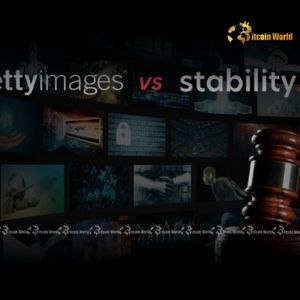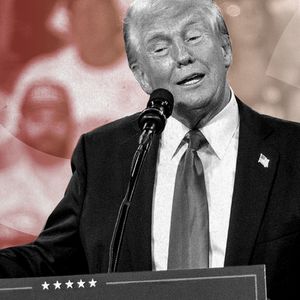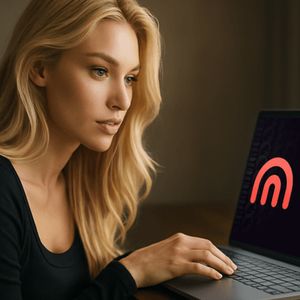BitcoinWorld AI Copyright: Crucial Shift in Getty Images vs. Stability AI Lawsuit In the rapidly evolving digital landscape, where blockchain innovation often intersects with cutting-edge technologies like artificial intelligence, understanding the legal frameworks governing AI is paramount. The recent developments in the AI copyright battle between industry giants Getty Images and Stability AI offer a compelling case study, shedding light on the intricate challenges and uncertainties facing generative AI companies and content creators alike. For those keenly observing the intersection of technology and intellectual property, this ongoing saga provides crucial insights into how digital assets, whether code or imagery, are being protected and leveraged in the age of intelligent machines. Understanding the Evolving Landscape of AI Copyright The legal skirmish between Getty Images, a global leader in visual content, and Stability AI, the startup behind the popular Stable Diffusion AI image generator, has been one of the most closely watched cases in the realm of artificial intelligence. It specifically concerns the use of copyrighted material for training AI models and the originality of their outputs. On Wednesday, a significant turn occurred at London’s High Court when Getty Images opted to drop its primary claims of direct copyright infringement against Stability AI. These claims centered on two core allegations: Training Infringement: Getty initially alleged that Stability AI utilized millions of copyrighted images from Getty’s extensive library to train its AI model without obtaining the necessary permissions or licenses. This claim struck at the heart of how AI models are built, raising questions about whether the ingestion of copyrighted data for ‘learning’ constitutes infringement. Output Infringement: The second primary claim asserted that the images generated by Stable Diffusion were not merely inspired but were substantially similar to Getty’s copyrighted content. Furthermore, Getty pointed out that some of these AI-generated works even bore its proprietary watermarks, suggesting a direct link to the original source material. This strategic withdrawal, as explained by legal experts such as Ben Maling, a partner at law firm EIP, likely stems from the inherent difficulties in proving these specific types of infringement within the UK legal framework. Maling suggested that Getty may have struggled to establish a sufficient connection between the alleged infringing training acts and the UK jurisdiction for copyright law to apply effectively. Similarly, proving output infringement proved challenging, as Getty likely failed to establish that what the models reproduced reflected a ‘substantial part’ of the original copyrighted images, a high bar in copyright law. Getty’s lawyers themselves framed the move as a strategic recalibration, allowing them to focus resources on what they believe are stronger, more winnable allegations. This development underscores the complex nature of proving direct copyright infringement when dealing with AI models that ‘learn’ from vast datasets rather than directly copying, highlighting the ‘gray areas’ that define the future of content ownership in the generative AI era. What Remains for the Getty Images Lawsuit ? Unpacking the Continuing Legal Battle While the initial claims have been dropped, the legal battle is far from over. Getty Images is still pursuing other significant allegations against Stability AI in the UK, as well as a separate, substantial lawsuit in the United States. The remaining claims in the UK focus on two critical areas: Secondary Infringement: This is a particularly impactful claim, as it argues that the AI models themselves might infringe copyright law. If successful, it could mean that merely using these models within the UK could constitute importing ‘infringing articles,’ even if the initial training occurred outside the UK. This claim holds wide-ranging implications for generative AI companies operating globally, as it could compel them to reconsider their operational models and the distribution of their AI products. As Ben Maling noted, “Secondary infringement is the one with widest relevance to genAI companies training outside of the UK, namely via the models themselves potentially being ‘infringing articles’ that are subsequently imported into the UK.” Trademark Infringement: Getty alleges that Stability AI’s models reproduced Getty’s distinctive watermarks, leading to potential trademark infringement and ‘passing off’ – implying that consumers might mistakenly associate the AI-generated content with Getty Images. This claim targets the brand reputation and commercial identity of Getty. Stability AI, however, remains confident that these claims will fail, asserting that consumers do not interpret the appearance of watermarks on AI-generated images as a commercial message or endorsement from Stability AI itself. Across the Atlantic, the stakes are even higher. Getty’s U.S. division filed a separate lawsuit in February 2023, escalating the legal pressure by alleging that Stability AI used as many as 12 million copyrighted images without permission. In this case, Getty is seeking damages for 11,383 specific works at an astonishing $150,000 per infringement, potentially totaling a staggering $1.7 billion. This massive figure highlights the financial magnitude and potential industry-shaping consequences of these legal disputes, emphasizing the profound economic implications for both content creators and AI developers. The Broader Implications for Generative AI and the Creative Industries The legal challenges faced by Stability AI are not isolated incidents; they are part of a larger, global conversation about the ethical and legal boundaries of generative AI. The core issue revolves around how AI systems ‘learn’ from vast datasets, often containing copyrighted material, and whether this learning process constitutes infringement. Just a day before Getty’s decision, a U.S. judge sided with Anthropic in a similar dispute regarding the use of books for AI training without author permission, indicating a nuanced and evolving judicial understanding of these issues. This suggests that courts are grappling with the specific mechanisms of AI training and output, rather than applying blanket rules. This landscape is further complicated by other ongoing cases that reflect the growing concerns of artists and creators. Stability AI, alongside fellow prominent AI image generators Midjourney and DeviantArt, is also facing a class-action complaint from a group of visual artists who allege widespread copyright infringement. These cases collectively highlight the urgent need for clearer legal guidelines, industry-wide standards, and potentially new licensing frameworks for AI development and deployment. The lack of established precedents means each case contributes to shaping future policy and practice. Interestingly, Getty Images itself has entered the generative AI space, underscoring the transformative potential of this technology even for those engaged in legal battles over its use. The company offers its own AI tool that leverages models trained exclusively on Getty’s vast iStock stock photography and video libraries. This proprietary tool allows users to generate new licensable images and artwork, providing a licensed and controlled environment for AI content creation. This dual role as both a plaintiff in copyright lawsuits and a developer in the generative AI market adds another layer of complexity to the ongoing discussions about fair use, licensing, and the future of creative industries. It demonstrates a recognition that while legal boundaries are being tested, the technology itself holds immense promise. Navigating AI Legal Challenges : A Glimpse into the Future of Intellectual Property The legal proceedings involving Getty Images and Stability AI are more than just a corporate dispute; they are a critical bellwether for the future of intellectual property in the age of artificial intelligence. The outcomes of these cases will undoubtedly set powerful precedents that could reshape how AI models are trained, how AI-generated content is regulated, and how creators are compensated for their invaluable contributions. This ongoing legal saga forces us to confront fundamental questions about creativity, ownership, and the very definition of ‘original work’ in an era where machines can generate art. Consider the following critical questions emerging from these challenges, which will dictate the trajectory of AI innovation: Data Licensing Paradigms: Will AI developers be universally required to license vast datasets for training, or will existing fair use doctrines expand to accommodate AI learning processes, perhaps under specific conditions? The answer will significantly impact the cost and accessibility of AI model development. Attribution and Royalties: How can original creators be properly attributed and fairly compensated when their work contributes, even indirectly, to AI models that generate new content? This is a crucial question for the sustainability of creative professions. Jurisdictional Hurdles and Global Harmonization: How will fragmented international laws adapt to the borderless nature of AI model training and deployment? Achieving some level of global legal harmonization may become essential for predictable AI development. Defining ‘Transformative Use’: When does an AI model’s use of copyrighted material become ‘transformative’ enough to fall under fair use, and when does it remain derivative? The courts are currently defining these nuanced boundaries. These questions underscore the profound impact that current legal battles will have on the innovation trajectory of generative AI and the broader digital economy. Companies, artists, and legal experts are all grappling with these complex issues, striving to find a delicate balance that fosters technological advancement while robustly protecting creative rights and ensuring fair compensation for intellectual labor. The precedents set here will resonate for decades. Stability AI ‘s Stance and the Road Ahead for Innovation Throughout these complex legal proceedings, Stability AI has maintained a resolute stance, expressing confidence in its defense against the remaining claims. A spokesperson for Stability AI conveyed their satisfaction, stating they were “pleased to see Getty’s decision to drop multiple claims after the conclusion of the testimony,” signaling their belief that the remaining claims, particularly trademark and passing off, will also prove unsuccessful. Their argument hinges on the idea that consumers do not interpret the appearance of watermarks on AI-generated content as an endorsement or commercial message directly from Stability AI itself, but rather as artifacts from the training data. The road ahead for both Getty Images and Stability AI, as well as the broader generative AI industry, is paved with significant legal uncertainty. The outcomes of the remaining UK claims, particularly the secondary infringement argument, and the substantial U.S. lawsuit, will be pivotal. These decisions will not only determine significant financial liabilities for the parties involved but will also establish critical legal interpretations that will guide future AI development, content creation, and intellectual property rights globally. As the legal landscape continues to evolve, stakeholders across technology, art, and law will be watching closely, understanding that these rulings will shape the future contours of the AI revolution and its impact on human creativity and innovation. The decision by Getty Images to narrow its UK lawsuit against Stability AI marks a significant, albeit not conclusive, moment in the ongoing debate over AI and copyright. It vividly highlights the inherent complexities of applying traditional intellectual property laws to the novel and transformative capabilities of generative AI. While some primary claims have been dropped, the core questions surrounding AI training data, the originality of AI-generated output, and the very nature of digital creation remain hotly contested and far from settled. The ultimate resolutions of these high-stakes legal battles will undoubtedly shape the future of creativity, commerce, and innovation in the AI era, setting crucial precedents for how content is used, valued, and protected in our increasingly intelligent world. This legal journey is a testament to the profound challenges and opportunities presented by AI, demanding careful consideration and forward-thinking solutions from all involved. To learn more about the latest AI legal challenges and generative AI trends, explore our article on key developments shaping AI models and their institutional adoption. This post AI Copyright: Crucial Shift in Getty Images vs. Stability AI Lawsuit first appeared on BitcoinWorld and is written by Editorial Team



















